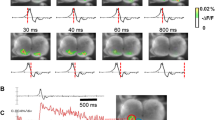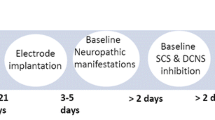Abstract
Serotonin reveals ineffective (subthreshold) pathways from the C2 lateral funiculus to ipsilateral phrenic motoneurons in spinalized rats. The objective of the present study was to investigate serotonergic modulation of crossed-spinal pathways to contralateral phrenic motoneurons. Rats (n = 10) were anesthetized (urethane), paralyzed, vagotomized, and artificially ventilated. The spinal cord was hemisected at C1–C2 and, on the intact side, a tungsten stimulating electrode was placed ventral to the C2 dorsal root entry zone in the dorsolateral (∼ 1.1 mm) or the ventrolateral funiculus (∼2.2 mm depth). Single shocks (100–750 μA, 0.1–0.5 ms, 2 Hz) elicited a short-latency (∼ 1.0 ms to peak) excitation in the ipsilateral phrenic nerve, but usually evoked little or no response in the contralateral phrenic nerve at either stimulus site. Following systemic injection of the monoamine oxidase inhibitor pargyline (25 mg/kg) and the serotonin precursor 5-hydroxytryptophan (5–10 mg/kg), complex responses were revealed in the contralateral phrenic nerve, including; (1) spontaneous tonic activity; (2) a short-latency (∼1.0 ms to peak) evoked excitation; and (3) two long-latency (∼2.2 and 7.8 ms to peak) evoked excitations. The longest latency excitation was expressed only when the stimulating electrode was positioned in the dorsolateral funiculus. Contralateral evoked responses were blocked by systemic methysergide (2–6 mg/kg), a broad-spectrum serotonin receptor antagonist. These results indicate that serotonin converts ineffective crossed phrenic pathways in the spinal cord to effective pathways. It remains to be determined whether serotonin is both necessary and sufficient in this modulatory process, or if it is a nonspecific result of increased phrenic motoneuron excitability.
Similar content being viewed by others
References
Anderson EG, Shibuya T (1966) The effects of 5-hydroxytryptophan and l-tryptophan on spinal synaptic activity. J Pharmacol Exp Ther 153(2):352–360
Bellingham MC, Lipski J (1990) Respiratory interneurons in the C5 segment of the spinal cord of the cat. Brain Res 533:141–146
Connelly CA, Ellenberger HH, Feldman JL (1989) Are there serotonergic projections from raphe and retrotrapezoid nuclei to the ventral respiratory group in the rat? Neurosci Lett 105:34–40
Ellenberger HH, Feldman JL, Goshgarian HG (1990) Ventral respiratory group projections to phrenic motorneurons: electron microscopic evidence for monosynaptic connections. J Comp Neurol 302:707–714
Feldman JL, Loewy AD, Speck DF (1985) Projections from the ventral respiratory group to phrenic and intercostal motoneurons in cat: an autoradiographic study. J Neurosci 5(8):1993–2000
Furicchia JV, Goshgarian HG (1987) Dendritic organization of phrenic motoneurons in the adult rat. Exp Neurol 96:621–634
Goshgarian HG, Ellenberger HH, Feldman JL (1991) Decussation of bulbospinal respiratory axons at the level of the phrenic nuclei in adult rats: a possible substrate for the crossed phrenic phenomenon. Exp Neurol 111:135–139
Guth L (1976) Functional plasticity in the respiratory pathway of the mammalian spinal cord. Exp Neurol 51:414–420
Holtman JR Jr (1988) Immunohistochemical localization of serotonin and substance P-containing fibers around respiratory muscle motoneurons in the nucleus ambiguus of the cat. Neuroscience 26(1):169–78
Holtman JR Jr, Dick TE, Berger AJ (1986) Involvement of serotonin in the excitation of phrenic motoneurons evoked by stimulation of the raphe obscurus. J Neurosci 6(4):1185–1193
Holtman JR Jr, Vascik DS, Maley BE (1990) Ultrastructural evidence for serotonin-immunoreactive terminals contracting phrenic motoneurons in the cat. Exp Neurol 109:269–272
Hounsgaard J, Hultborn H, Jespersen B, Kiehn O (1988) Bistability of α-motoneurones in the decerebrate cat and in the acute spinal cat after intravenous 5-hydroxytryptophan. J Physiol (Lond) 405:345–367
Hugelin A (1986) Forebrain and midbrain influence on respiration. In: Cherniack NS, Widdicombe JG (eds) Handbook of Physiology, sect 3. The respiratory system, vol II, American Physiological Society, Bethesda, Md, pp 69–91
Jacobs BL, Azmitia EC (1992) Structure and function of the brain serotonin system. Physiol Rev 75(1):165–229
Jiang C, Mitchell GS, Lipski J (1991) Prolonged augmentation of respiratory discharge in hypoglossal motoneurons following superior laryngeal nerve stimulation. Brain Res 538:215–225
Jiang Z-H, Shen E (1985) Synaptic connection between monoaminergic terminals and intercostal respiratory motoneurons in cats. Acta Physiol Scand 37(5):479–485
Lalley PM (1986) Responses of phrenic motoneurones of the cat to stimulation of medullary raphe nuclei. J Physiol (Lond) 380:349–371
Lindsay AD, Feldman JL (1993) Modulation of respiratory activity of neonatal rat phrenic motoneurons by serotonin. J Physiol (Lond) 461:213–233
Lipski J, Duffin J, Kruszewska B, Zhang X (1993a) Upper cervical inspiratory neurons in the rat: an electrophysiological and morphological study. Exp Brain Res 95(3):477–487
Lipski J, Zhang X, Kruszewska B, Kanjhan R (1993b) Tracing long axonal projections of intracellular-labelled neurons “in vivo”. Proc Aust Neurosci Soc 4:94
Millhorn DE (1986) Stimulation of raphe (obscurus) nucleus causes long-term potentiation of phrenic nerve activity in cat. J Physiol (Lond) 381:169–179
Mitchell GS, Sloan HE, Jiang C, Miletic V, Hyashi F, Lipski J (1992) 5-Hydroxytryptophan augments spontaneous and evoked phrenic motoneuron discharge in spinalized rats. Neurosci Lett 141:75–78
Moreno DE, Yu XJ, Goshgarian HG (1992) Identification of the axon pathways which mediate functional recovery of a paralyzed hemidiaphragm following spinal cord hemisection in the adult rat. Exp Neurol 116(3):219–228
Pilowsky PM, Castro D de, Llewellyn-Smith I, Lipski J, Voss MD (1990) Serotonin immunoreactive boutons make synapses with feline phrenic motoneurons. J Neurosci 10(4):1091–1098
Plum F (1970) Neurological integration of behavioural and metabolic control of breathing. In: Porter R (ed) Breathing: Hering-Breuer Centenary Symposium. Churchill, London, pp 159–174
Porter WT (1895) The path of the respiratory impulse from the bulb to the phrenic nuclei. J Physiol 17:455–485
Saether K, Hilaire G, Monteau R (1987) Dorsal and ventral respiratory groups of neurons in the medulla of the rat. Brain Res 419:87–96
Samathanam G, Duffy P, Kalivas PW, White SR (1989) A comparison of 5-hydroxytryptophan effects on rat lumbar spinal cord serotonin release and monosynaptic response amplitude. Brain Res 501:179–182
Schmid K, Böhmer G, Merkelbach S (1990) Serotonergic control of phrenic motoneuronal activity at the level of the spinal cord of the rabbit. Neurosci Lett 116:204–209
Schmidt AW, Peroutka SJ (1989) 5-Hydroxytryptamine receptor “families”. FASEB J 3:2242–2249
Skagerberg G, Bjorklund A (1985) Topographic principles in the spinal projections of serotonergic and non-serotonergic brainstem neurons in the rat. Neuroscience 15(2):445–480
Stein RB, Capaday C (1988) The modulation of human reflexes during functional motor tasks. Trends Neurosci 11:328–332
Voss MD, De Castro D, Lipski J, Pilowsky PM, Jiang C (1990) Serotonin immunoreactive boutons form close appositions with respiratory neurons of the dorsal respiratory group in the cat. J Comp Neurol 295:208–218
White SR, Fung SJ (1989) Serotonin depolarizes cat spinal motoneurons in situ and decreases motoneuron after hyperpolarizing potentials. Brain Res 502:205–213
Wolpaw JR, Lee CL, Carp JS (1991) Operantly conditioned plasticity in spinal cord. Ann NY Acad Sci 627:338–348
Yamada H, Ezure K, Manabe M (1988) Efferent projections of inspiratory neurons of the ventral respiratory group. A dual labeling study in the rat. Brain Res 455:283–294
Zhan W-Z, Ellenberger HH, Feldman JL (1989) Monoaminergic and GABAergic terminations in phrenic nucleus of rat identified by immunohistochemical labeling. Neuroscience 31(1):105–113
Zheng Y, Barillot JC, Bianchi AL (1992) Medullary expiratory neurons in the decerebrate rat: an intracellular study. Brain Res 576:245–253
Author information
Authors and Affiliations
Rights and permissions
About this article
Cite this article
Ling, L., Bach, K.B. & Mitchell, G.S. Serotonin reveals ineffective spinal pathways to contralateral phrenic motoneurons in spinally hemisected rats. Exp Brain Res 101, 35–43 (1994). https://doi.org/10.1007/BF00243214
Received:
Accepted:
Issue Date:
DOI: https://doi.org/10.1007/BF00243214




